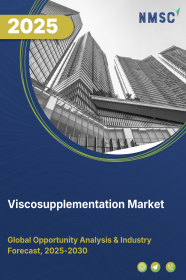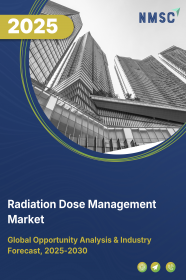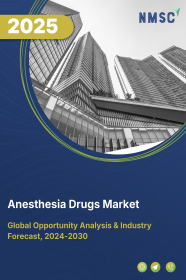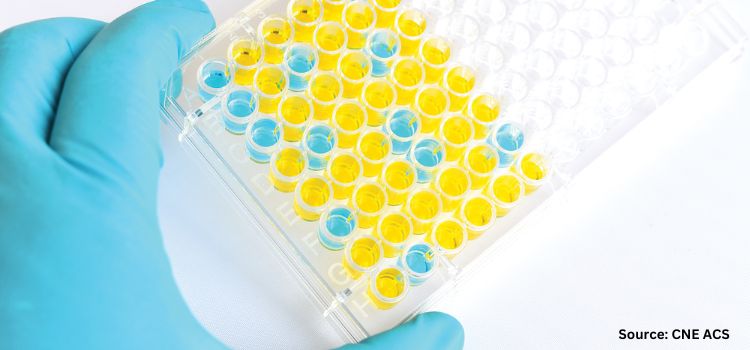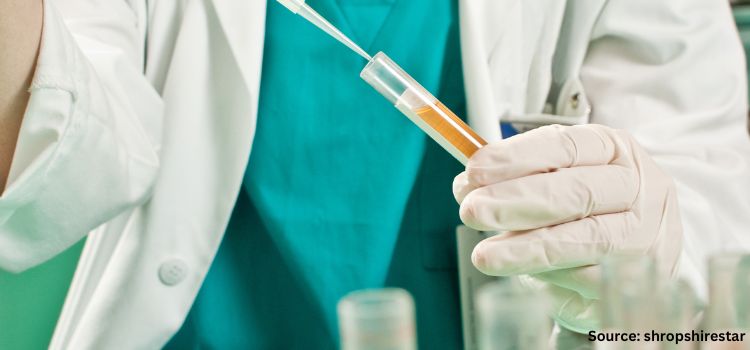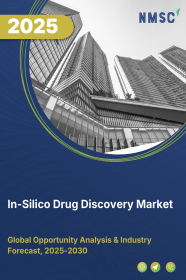
In-Silico Drug Discovery Market by Product Type (Software, Software-as- a-Service and Other), by Drug Type (Small Molecule, and Others), by Workflow (Discovery, and Others), by Software (Molecular Modelling and Other), by Technology (AI, and Other), by Target Therapeutic Area (Metabolic Disorders, HIV, and Others), by Application (Target Identification, and Other), and by End Users (Healthcare and Others)– Global Opportunity Analysis and Industry Forecast, 2025-2030
US Tariff Impact on In-Silico Drug Discovery Market
Trump Tariffs Are Reshaping Global Business
In-Silico Drug Discovery Industry Overview
The global In-Silico Drug Discovery Market size was valued at USD 3.61 billion in 2024 and is predicted to reach USD 4.07 billion by the end of 2025. The industry is predicted to reach USD 7.22 billion by 2030 with a CAGR of 12.2% from 2025 to 2030.
The market is experiencing significant advancements driven by growing demand for AI-powered drug discovery, increasing adoption of virtual clinical trials, and expanding investments in computational biology. The market is being propelled by key drivers such as the reduction in development timelines, cost-efficiency, and the precision of virtual simulations. However, the market faces challenges such as regulatory hurdles and concerns over data privacy and cybersecurity. On the contrary, integration of AI drives innovation and creates opportunity for market growth.
Enhancing Drug Discovery Efficiency Drives In-Silico Drug Discovery Market Growth
The ability to accelerate drug discovery timelines is one of the most significant advantages of in silico technologies. By simulating various biological systems digitally, companies can test hypotheses and make decisions quickly without the need for prolonged laboratory experiments. For instance, Insilico Medicine’s AI-driven platform speeds up the drug discovery process by predicting the molecular behavior of drug candidates much faster than traditional methods. This not only reduces time but also allows for the rapid iteration of drug designs, thus speeding up time to market.
Cost-Efficiency in Drug Development Drives the Market Growth
The cost of drug development, especially in the early stages, is notoriously high. In silico methods significantly mitigate this challenge by eliminating many of the costly steps in conventional drug development, such as lab tests, animal trials, and clinical experimentation. Virtual simulations provide an efficient way to assess drug efficacy, toxicity, and metabolism before any physical trials begin, cutting down costs and resource usage. These cost savings make in silico approaches a highly attractive option for pharmaceutical companies looking to optimize their R&D budgets.
Personalized Medicine with In Silico Simulations Fuels In-Silico Drug Discovery Market Demand
In silico models are increasingly being used to drive personalized medicine, where treatments are tailored to the genetic profile of individual patients. By using patient-specific data, these models predict how certain drugs will perform for specific individuals. In silico methods help identify the most effective and least harmful drug options for different genetic makeups, improving the success rate of treatments and minimizing side effects. This trend towards personalized medicine is expected to grow, as more pharmaceutical companies move toward precision health, leveraging in silico simulations to create bespoke treatment plans.
Regulatory Hurdles Hinder In-Silico Drug Discovery Market Expansion
Despite its benefits, in silico drug discovery and testing methods still face challenges related to regulatory acceptance. Regulatory bodies such as the FDA and EMA have yet to fully integrate in silico methods into their approval processes, particularly in the later stages of clinical trials. This limits the widespread adoption of in silico technologies and adds a layer of complexity for companies that are keen on using these tools for drug approval. As regulatory bodies evolve their standards, it is likely that this barrier will gradually diminish, but for now, it remains a key restraint for market players.
Integration of AI Drives Innovation and Creates Opportunity for Market Growth
Industry players in the market can benefit greatly from collaborations with tech companies specializing in AI integration, machine learning, and big data analytics. These partnerships can help enhance the computational power and modeling accuracy of in silico tools, further optimizing drug discovery processes. Tech firms, with their expertise in software and data analytics, can work with pharmaceutical companies to fine-tune their drug development strategies, leading to faster and more precise results. This collaboration could revolutionize drug discovery, creating new opportunities for innovation and market growth.
For instance, in 2024, Insilico Medicine partnered with NVIDIA to launch an AI-powered platform designed to accelerate drug discovery. The collaboration leverages NVIDIA’s advanced GPU technology and AI capabilities to enhance the processing speed of in silico simulations. This platform enables pharmaceutical companies to screen potential drug candidates at a fraction of the time and cost compared to traditional methods. The combination of NVIDIA’s AI expertise and Insilico’s drug discovery technology has the potential to significantly reduce the timeline for developing new drugs, positioning this collaboration as a major step forward in the industry.
Market Segmentations and Scope of the Study
The in-silico drug discovery market report is segmented on the basis of product type, drug type, workflow, software type, technology, target therapeutic area, application, end user, and region. On the basis of product type, the market is divided into software, software-as-a-service (SaaS), and consultancy-as-a-service. On the basis of drug type, the market is segmented into small molecules, biologics, and antibodies. On the basis of workflow, the market is segmented into discovery, pre-clinical tests, and clinical tests. The discovery segment is further divided into target identification, target validation, and lead discovery. The target identification segment is further segmented into bioinformatics, reverse docking, and protein structure prediction. The lead discovery segment is further categorized into library design and pharmacophore. On the basis of software type, the market is segmented into molecular modelling and de novo drug design software and pharmacophore modelling software. On the basis of technology, the market is segmented into artificial intelligence, graphics processing unit (GPU), and other technologies. On the basis of target therapeutic area, the market is segmented into metabolic disorders, HIV, infectious diseases, mental disorders, neurological disorders, and oncological disorders. On the basis of application, the market is segmented into target identification, lead optimization, preclinical testing, clinical trials, and adverse effect prediction. On the basis of end user, the market is segmented into contract research organizations, pharmaceutical and biopharmaceutical companies, academic and research institutes, and others. Regional breakdown and analysis of each of the aforesaid segments include regions comprising North America, Europe, Asia-Pacific, and RoW.
Geographical Analysis
North America dominates the in-silico drug discovery market share, driven by substantial investments in research and development, particularly in the U.S. and Canada. The presence of major pharmaceutical companies, biotechnology firms, and cutting-edge tech firms specializing in AI and machine learning significantly contributes to the region's growth.
North America’s highly developed healthcare infrastructure and the increasing adoption of in silico tools for drug discovery and clinical trials further solidify its leadership. Market players in this region are focusing on the integration of advanced computational technologies to streamline drug development and optimize healthcare solutions.
Moreover, regulatory support for digital health technologies continues to boost market confidence and growth potential in this region. The North American market size is expected to expand rapidly, particularly as collaborations between pharma and tech companies proliferate.
Europe is witnessing robust growth in the market, driven by advancements in digital health, bioinformatics, and personalized medicine. With countries like Germany, the UK, and Switzerland at the forefront, Europe emphasizes sustainability and environmental impact, promoting green technologies in the pharmaceutical and healthcare industries. The European Union’s Digital Single Market strategy and its regulations that encourage the adoption of AI in healthcare further propel this region’s market expansion.
Additionally, Europe’s strong emphasis on collaborative research, with initiatives involving public and private sectors, creates ample opportunities for the market. The market share in this region is expected to see continuous growth as more organizations adopt in silico methods to improve the efficiency of drug development and minimize the environmental footprint of traditional clinical trials.
Asia-Pacific presents one of the highest growth potentials for the market, primarily due to rapid industrialization, a burgeoning healthcare sector, and increasing investments in digital health solutions. Countries like China, Japan, India, and South Korea are emerging as key players in the pharmaceutical and biotechnology industries.
The region benefits from a large patient population, making it an ideal environment for drug discovery and clinical trials using in silico models. The increasing use of AI, big data analytics, and advanced computational tools to optimize drug development processes is a significant market trend in Asia-Pacific.
Additionally, favorable government policies and increasing collaborations between academia, healthcare organizations, and tech companies are propelling the region’s growth. As demand for precision medicine rises, the market size in this region is expected to grow substantially.
The Rest of the World (RoW) encompasses regions such as Latin America, Africa, and the Middle East, where the industry is witnessing gradual expansion. In these regions, improving healthcare infrastructure and increasing access to digital technologies are key drivers.
Governments and private organizations in Latin America and Africa are investing heavily in healthcare modernization, with a strong focus on expanding access to innovative drug discovery and clinical research technologies. While market development is slower compared to North America and Europe, the potential for growth in RoW is significant, especially as countries in the Middle East and Africa embrace digital health technologies to improve patient outcomes.
The adoption of in silico tools in these emerging markets presents ample opportunities for international companies looking to expand their reach and contribute to the global healthcare transformation. The market growth in RoW is expected to accelerate as regulatory frameworks evolve to support digital health integration and the benefits of computational drug discovery become more apparent.
Strategic Approaches in the Evolving In Silico Industry
In the global in silico industry, key players are adopting innovative strategies to stay ahead in the competitive landscape, focusing on expanding their market share and enhancing drug discovery processes. Companies such as Insilico Medicine, Schrödinger, and Veristat are integrating advanced technologies like artificial intelligence (AI), machine learning, and big data analytics into their in-silico platforms to boost drug development efficiency and precision. For instance, Insilico Medicine recently advanced its AI-driven drug discovery platform, leveraging deep learning algorithms to design novel compounds, significantly reducing the time required for drug development.
Similarly, Schrödinger’s collaboration with pharmaceutical giants like Bristol Myers Squibb highlights the growing use of in silico models for optimizing molecular design and improving the success rate of clinical trials. However, these players face challenges such as high computational costs, the complexity of data integration, and regulatory hurdles in different markets. The increasing need for more robust cybersecurity measures in drug discovery platforms also poses a challenge.
Nonetheless, opportunities abound in emerging markets, particularly in Asia-Pacific and Latin America, where there is a surge in digital healthcare adoption. The industry's growth potential is further enhanced by the ongoing advancements in AI and the increasing focus on personalized medicine, offering a promising outlook for both established and emerging companies.
Key Benefits
-
The report provides quantitative analysis and estimations of the market from 2025 to 2030, which assists in identifying the prevailing market opportunities.
-
The study comprises a deep dive analysis of the current and future in-silico drug discovery market trends to depict prevalent investment pockets in the market.
-
Information related to key drivers, restraints, and opportunities and their impact on the in-silico drug discovery sector is provided in the report.
-
Competitive analysis of the players, along with their market share is provided in the report.
-
SWOT analysis and Porters Five Forces model is elaborated in the study.
-
Value chain analysis in the market study provides a clear picture of roles of stakeholders.
In-Silico Drug Discovery Market Key Segments
By Product Type
-
Software
-
Software-as- a-Service (SaaS)
-
Consultancy-as-a-Service
By Drug Type
-
Small Molecules
-
Biologics
-
Antibodies
By Workflow
-
Discovery
-
Target Identification
-
Bioinformatics
-
Reverse Docking
-
Protein Structure Prediction
-
-
Target Validation
-
Lead Discovery
-
Library Design
-
Pharmacophore
-
-
-
Pre-Clinical Tests
-
Clinical Tests
By Software Type
-
Molecular Modelling and De Novo Drug Design Software
-
Pharmacophore Modelling Software
By Technology
-
Artificial Intelligence
-
Graphics Processing Unit (GPU)
-
Other Technologies
By Target Therapeutic Area
-
Metabolic Disorders
-
HIV
-
Infectious Diseases
-
Mental Disorders
-
Neurological Disorders
-
Oncological Disorder
By Application
-
Target Identification
-
Lead Optimization
-
Preclinical Testing
-
Clinical Trials
-
Adverse Effect Prediction
By End Users
-
Contract Research Organizations
-
Pharmaceutical and Biopharmaceutical Companies
-
Academic and Research Institutes
-
Others
By Region
-
North America
-
The U.S.
-
Canada
-
Mexico
-
-
Europe
-
The UK
-
Germany
-
France
-
Italy
-
Spain
-
Denmark
-
Netherlands
-
Finland
-
Sweden
-
Norway
-
Russia
-
Rest of Europe
-
-
Asia Pacific
-
China
-
Japan
-
India
-
South Korea
-
Australia
-
Indonesia
-
Singapore
-
Taiwan
-
Thailand
-
Rest of Asia Pacific
-
-
RoW
-
Latin America
-
Middle East
-
Africa
-
Key Players
-
Evotec SE
-
Charles River Laboratories International, Inc.
-
Insilico Medicine
-
Schrodinger, Inc.
-
Certara
-
Ligand Pharmaceuticals
-
Aragen Life Sciences
-
Numerate Inc.
-
Simulations Plus, Inc.
-
Curia Global Inc.
-
GenScript
-
Abzena Ltd.
-
Creative Biostructure
-
Amazon Web Service Inc.
-
Parexel
REPORT SCOPE AND SEGMENTATION:
|
Parameters |
Details |
|
Market Size in 2024 |
USD 3.61 Billion |
|
Revenue Forecast in 2030 |
USD 7.22 Billion |
|
Growth Rate |
CAGR of 12.2% from 2025 to 2030 |
|
Analysis Period |
2024–2030 |
|
Base Year Considered |
2024 |
|
Forecast Period |
2025–2030 |
|
Market Size Estimation |
Billion (USD) |
|
Growth Factors |
|
|
Countries Covered |
28 |
|
Companies Profiled |
15 |
|
Market Share |
Available for 10 companies |
|
Customization Scope |
Free customization (equivalent up to 80 working hours of analysts) after purchase. Addition or alteration to country, regional, and segment scope. |
|
Pricing and Purchase Options |
Avail customized purchase options to meet your exact research needs. |

















 Speak to Our Analyst
Speak to Our Analyst



